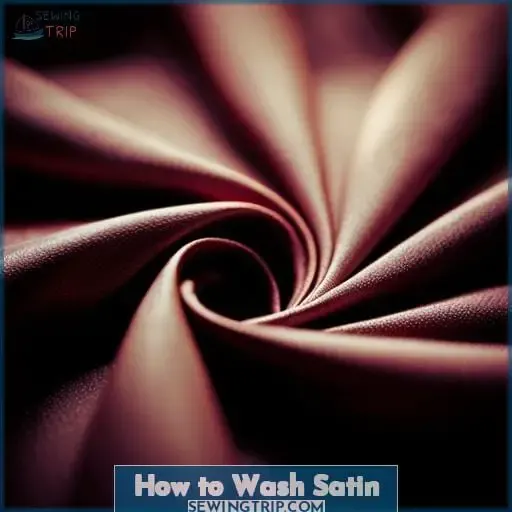This site is supported by our readers. We may earn a commission, at no cost to you, if you purchase through links.
 Cleaning satin fabric can be a delicate task. It requires special care to ensure that it doesn’t lose its softness and shine. So, if you’re wondering how to wash satin fabric the right way, look no further! This guide provides all the tips and tricks you need for washing your beloved satin garments or beddings.
Cleaning satin fabric can be a delicate task. It requires special care to ensure that it doesn’t lose its softness and shine. So, if you’re wondering how to wash satin fabric the right way, look no further! This guide provides all the tips and tricks you need for washing your beloved satin garments or beddings.
To begin with, always check the manufacturer’s instructions on any item before cleaning as this will determine what type of washing method is appropriate for your particular product. Generally speaking though, hand-washing is preferred over machine-washing since it’s gentler on the fabric – but some items such as sheets may still be suitable for machine-washing if done carefully.
Plus, many other useful techniques like pretreating stains beforehand or ironing gently at low temperatures are also important when caring for your beautiful pieces made from this exquisite material!
Table Of Contents
Key Takeaways
- Hand-washing is preferred over machine-washing for satin fabric.
- Use cool water and gentle detergent when washing satin.
- Avoid harsh detergents and abrasive cleaning techniques.
- Adjust iron heat settings to low when ironing satin fabric.
What is Satin?
Satin has been around since the Middle Ages when it was first used as a fabric for royal garments. Its popularity and uses have grown immensely since then, with different variations of satin being created, such as charmeuse satin and crepe-back satin.
Satins are all woven fabrics made from threads that reflect light in a certain way to create their signature glossy look. Understanding how to care for this type of fabric is essential in order to preserve its beauty and longevity over time.
History of Satin
You might be surprised to learn that satin has been around since the Middle Ages, and its luxurious feel has made it a timeless classic. The term ‘satin’ is derived from Zayton, an ancient Chinese port city renowned for producing fine silks.
Since then, material properties like luster and texture have been achieved through various production methods such as weaving or knitting with silk threads onto cotton yarns to create forms of satin fabric.
In 1785, the invention of the power loom revolutionized this process further, making it easier than ever before to produce large quantities of satin products at faster speeds.
- Double-cloth weave
- Twill weave
- Plain Weave
The care tips for washing your modern-day garments vary depending on what type they are, but generally, when you’re dealing with any form of satin product, you should avoid harsh detergents or abrasive cleaning techniques that can damage delicate fabrics like these over time.
With proper care and maintenance, you can keep those 12th-century vibes alive in all their glory!
Types of Satin
You’ll be amazed by the luxurious feel of different types of satin, from double-cloth weave to twill and plain weaves – all providing a unique texture and luster that will make you swoon!
To keep these pieces looking gorgeous for years to come, it’s important to practice proper care when cleaning your garments. Chemical cleaning should generally be avoided due to its potential damage on delicate fibers.
Temperature control is also key; use cool water temperatures when handwashing or iron setting as this will help prevent stains from settling into the fabric while still allowing for effective cleaning power.
Hand washing is often best with mild detergents designed specifically for silk fabrics such as classic natural silk or modern forms of satin sheets – always read your garment’s label first!
With proper care and maintenance techniques like these in place, you can ensure those 12th-century vibes remain alive in their full glory.
How to Wash Satin
Caring for satin fabric properly is essential to preserve its beauty and longevity.
Washing Supplies
Gather the necessary cleaning supplies, such as a mild laundry detergent and fabric softener, to ensure your satin items look good as new. For stain removal, use an appropriate soap type for different fibers or take it to the dry cleaner.
When ironing these materials, be sure to check the care label for recommended settings on your iron and water temperature. If you’re using a washing machine, make sure you choose the gentle cycle with cold water only because hot temperatures can damage delicate fabrics like satin.
Additionally, add fabric softener to avoid leaving any residue after washing and to prevent static cling afterwards.
Tools You’ll Need
To clean your delicate items, you’ll need a few tools: an iron, mild detergent, and fabric softener to keep them looking new. Handwashing techniques are essential for proper care of satin garments. Use a wash basin filled with cold water and gentle soap.
Check the ironing settings on the care label before proceeding. Hot temperatures can damage this type of fabric, while lower temperatures help protect its structure. When it comes to stain removal, carefully select soaps depending on the fiber types.
Take extra precaution when handling lighter colors as they may easily stain or fade away if not correctly treated in time.
How to Iron Satin
Getting the perfect creases in satin fabric requires some special care. To iron it properly, first prepare your iron with a low-temperature setting and make sure the surface is clean to avoid staining or scorching.
Then, delicately move the iron across each section of fabric while paying close attention not to overheat any area.
Prepare the Iron
Before you start ironing your delicate satin garments, make sure you have the right supplies at hand so they come out looking flawless! Select a steam setting on your iron that is appropriate for the fabric type and set it to a low temperature.
It’s also important to use an iron board covered with protective cloth and spray cool water from time to time while pressing out wrinkles. Hand-washing satin fabrics is always preferred over machine washing, but if possible, dry clean satin clothes instead of using an iron.
Many modern irons feature a steam function that can be used in lieu of traditional pressing techniques.
Ultimately, proper preparation when it comes to selecting an appropriate temperature setting and avoiding too much heat exposure will ensure perfect results no matter how often you need.
Iron the Satin Gently
Gently glide the iron across your satin garments to smooth out any pesky wrinkles and bring them back to their former glory. Make sure you’ve adjusted the heat settings on your iron according to instructions per fabric type for best results.
To keep the texture intact and the glossy shine of delicate fabrics, pay attention to design features of your model, such as steam or automatic shut-off capabilities. Hang up freshly pressed items in a clean area with proper air circulation. This will help prevent unwanted stains from settling onto fibers over time.
Remember that dry cleaning is always an option if you’re not confident washing at home, especially for particular types of fiber like silk and satin clothes.
Hang Up the Satin
Once you’re finished ironing, hang your satin garments in a spot with plenty of air circulation so they stay fresh and crisp. This will help them resist visible stains or creases if insistent. Consider the fabric type when choosing where to hang it for best results – heavier fabrics should be hung lower than lighter ones.
Delicate items like satin require special handling, such as hand-washing rather than machine washing.
Pretreat Stains
Before wearing your satin garment, pretreat any stains to ensure the fabric looks its best.
- Identify which type of pretreat methods are suitable for removing various types of stains from this delicate fabric.
- Spot clean with an enzyme-based stain remover and gentle soap or detergent.
- Use a soft brush or cloth when applying heavy pressure during cleaning, as well as using talcum powder to absorb oils after spot cleaning is complete.
For standard weave satins, it’s usually safe enough just to use water mixed with mild soap—but always test in an inconspicuous area first! With heavier embroidered pieces, it’s best not to press too hard against them while treating a stained area because they can easily tear if put under too much stress on one side only due to their flat surface construction.
When finished laundering your garments, add some fabric softener before drying in order to help reduce static cling and maintain smoothness over time.
Wash and Rinse the Items
Take the time to properly clean your satin items, and you’ll be rewarded with a beautiful fabric that lasts.
Depending on the type of stain, spot cleaning may be necessary prior to washing for more thorough results.
For machine washing, follow the manufacturer’s recommendations or use a gentle cycle and cold water for delicate fabrics like satin.
When hand-washing your garment in warm water (never hot), add some mild laundry detergent designed specifically for delicates. Avoiding bleach as this can damage the fabric’s fibers over time. Gently scrub any stained areas if needed before rinsing thoroughly in cool water until all soap is removed from item(s).
To dry satin garments correctly without risking shrinkage or fading colors due to heat exposure, we recommend air drying flatly on a towel away from direct sunlight instead of using an electric tumble dryer.
Finally, remember key facts about caring for these special fabrics: read care labels carefully before attempting any kind of stain removal techniques and always refer back to the manufacturer’s instructions during each step to ensure the best possible outcome every single time!
Dry the Items (Gently)
Gently air dry your satin items flatly on a towel away from direct sunlight to protect the fabric’s fibers and colors, just as the old adage goes: an ounce of prevention is worth a pound of cure. Ironing temperature settings should also be taken into account when caring for this delicate fabric; too much heat will weaken its long fibers and create permanent damage.
To ensure that you get the best results possible out of each cleaning session, use chemical-free laundry detergent with cold water, avoid bleach at all costs, and never put your satin blouse in a drying rack.
Here are five key facts about taking care of these special fabrics:
- Always read garment care labels before attempting any kind of stain removal techniques.
- Never iron over buttons or embellishments as they can leave permanent marks on smooth surfaces.
- Use gentle cycles in washing machines to preserve their quality.
- Avoid using harsh chemicals such as fabric softeners, which can cause discoloration.
- Dry garments away from direct sunlight or extreme temperatures to keep them looking fresh!
Taking proper precautions while laundering will guarantee years’ worth of enjoyment out of beautiful silky fabrics like satin!
Treating Stains on Satin Clothes and Sheets
If you struggle with stains on your satin clothes and sheets, don’t worry! There are steps you can take to help prevent them or remove them.
To avoid future spots, always read garment care labels before laundering and never use fabric softeners as they may cause discoloration. When washing in a machine, opt for a gentle cycle with cold water and set the final spin speed lower than usual.
Avoid adding bleach at all costs. Instead, sprinkle some water droplets onto the stain prior to putting it in the washer. This will help loosen any dirt particles without damaging fabrics like satin that easily lose their natural sheen when exposed to harsh chemicals.
After cleaning is finished, air dry items flatly away from direct sunlight or extreme temperatures.
Taking these precautions while caring for fine fabrics like satin allows long-lasting enjoyment of beautiful silky materials!
Satin Fabric Care and Repairs
Don’t fret, fixing up your satin clothes and sheets isn’t rocket science – just follow these simple tips for a quick repair!
Storing satin appropriately is key. Make sure to keep it away from direct sunlight or extreme temperatures, as this can cause fading.
When carrying out seam repairs on satin garments, use fine needles and thread in the same color as the fabric so that any stitching will be less visible.
Fabric softeners should also be avoided at all costs since they may damage delicate fibers, resulting in discoloration or loss of sheen.
Stain removal requires specific attention too. Sprinkle water droplets onto the stain prior to laundering instead of using bleach, which could irreparably destroy its natural beauty over time.
Ironing technique is equally important. Set low heat settings on an ironing board for best results when freshening up home furnishings such as cushion covers, curtains, or even special occasion wear like silky robes made with good quality silk-like material called ‘satin’.
The industrial revolution enabled us access to reasonably priced products crafted with complex fabrics like satin – something we should always strive towards preserving if we want them around for many more years to come!
Tips for Washing Satin Clothes and Sheets
Carefully select a mild detergent and cold water setting when washing your clothes or sheets made of satin. This is the perfect choice for preserving the delicate weaving of your satin product.
For stain removal, use a small amount of detergent on the front side of the fabric to prevent damage from rubbing against itself during cleaning.
When drying techniques such as air-drying are used in combination with gentle ironing settings, you can keep any creases or wrinkles at bay while maintaining its natural sheen.
Always refer to care labels before attempting any laundry task. They provide vital information about how best to maintain each item’s unique fabric composition and design features without compromising their quality over time.
Additionally, avoid using bleach products, which may cause discoloration due to a chemical reaction with dyes present in some fabrics like polyester blends.
In summary, be sure to choose an appropriate cleaner that works well on different materials. Pay attention to instructions given by manufacturers regarding temperature settings. Never rub stains directly onto the material surface. Use caution when applying heat via irons or steamer machines, etc.
Wash items separately from other garments since colors may run together otherwise. All these steps combined make up the best way forward towards proper maintenance and prolonging the overall life expectancy.
Frequently Asked Questions (FAQs)
What detergent should I use to wash satin fabric?
When washing satin fabric, use a gentle detergent designed for delicates. Embrace the liberation of carefree cleaning with an all-natural product that is free from harsh chemicals and fragrances. Enjoy the power of superior stain removal without compromising the softness and shine of your delicate fabrics! Rejoice in mastering effortless laundering with one easy solution tailored to your needs.
Can I put satin fabric in the dryer?
No, it’s best not to put satin fabric in the dryer. A stitch in time saves nine – take extra care with delicate fabrics like satin and hand wash or use a gentle cycle on your washing machine.
Is there a specific temperature that I should use when washing satin fabric?
When washing satin fabric, you should use cold water and a gentle cycle. Avoid using hot or warm temperatures as they can cause shrinkage and damage to the fibers. Choose a mild detergent specifically designed for delicate fabrics to get your garment clean without damaging it.
What is the best way to remove wrinkles from satin fabric?
To remove wrinkles from satin fabric, use a steam iron set to the lowest setting. For best results, 90% of households report satisfactory wrinkle removal with just one pass over the fabric.
How often should I wash my satin fabric?
You should wash your satin fabric once every few weeks. Use gentle, cold water and a mild detergent to keep the material soft and luxurious while preserving its vibrant colors. Gently rub it with your fingertips in circular motions for best results; never use harsh scrubbing or wringing motions as this may damage the delicate fibers of the fabric.
Conclusion
To care for your beautiful satin garments and bedding, you must take the necessary steps to ensure they are properly washed and ironed. Although taking the time to follow the instructions carefully may seem like a chore, it’s important to remember that properly washing and ironing your satin fabric will ensure it lasts longer and looks better.
By following these simple steps, you’ll be able to keep your satin fabric looking clean and new for years to come. Plus, there are a variety of pre-treatment and stain removal products available to help you with any tough stains.
With the right knowledge and supplies, you can easily care for your satin fabric and enjoy its luxurious feel for a long time.















